TRANSLATIONS IN A COORDINATE PLANE
Subscribe to our ▶️ YouTube channel 🔴 for the latest videos, updates, and tips.
Translations in a coordinate plane can be described by the following coordinate notation :
(x, y) ----> (x + a, y + b)
where a and b are constants. Each point shifts a units horizontally and b units vertically.
Example 1 :
Describe the translation in the coordinate plane shown below.
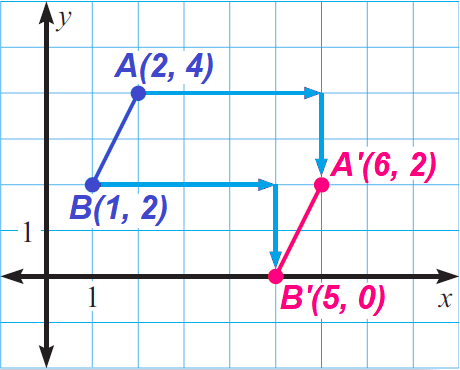
Solution :
In the coordinate plane shown above, the translation is
(x, y) ----> (x + 4, y - 2)
That is, the translation in the coordinate plane above shifts each point 4 units to the right and 2 units down.
Example 2 :
Sketch a triangle with vertices P(3, -1), Q (1, 1) and R(3, 5). Then sketch the image of the triangle after a translation to the right by 4 units and up by 2 units.
Solution :
First graph ΔPQR.
We have to do a translation to the right by 4 units and up by 2 units.
So the image vertices should all be 4 units to the right and 2 units up from the preimage vertices.
That is,
P(3, 1) ----> (3 + 4, - 1 + 2) ----> P'(7, 1)
Q(1, 1) ----> (1 + 4, 1 + 2) ----> P'(5, 3)
R(3, 5) ----> (3 + 4, 5 + 2) ----> P'(7, 7)
Label the image vertices P'(7, 1), Q'(5, 3), and R'(7, 7). Then, using a straightedge, draw ΔP'Q'R'.
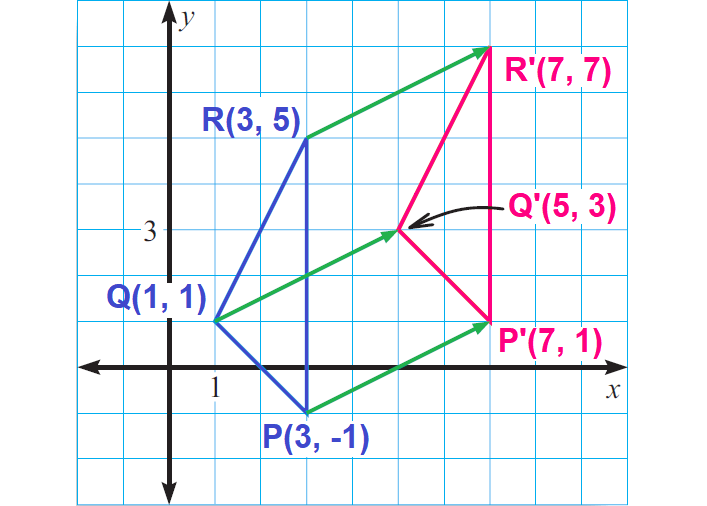
Example 3 :
Sketch a triangle with vertices A(- 1, - 3), B(1, - 1), and C( - 1, 0). Then sketch the image of the triangle after the translation (x, y) ----> (x - 3, y + 4).
Solution :
First graph ΔABC.
From (x, y) ----> (x - 3, y + 4), it is clear that we have to do a translation to the left by 3 units and up by 4 units.
So the image vertices should all be 3 units to the left and 4 units up from the preimage vertices.
That is,
P(- 1, - 3) ----> (- 1 - 3, - 3 + 4) ----> P'(- 4, 1)
Q(1, - 1) ----> (1 - 3, - 1 + 4) ----> Q'(- 2, 3)
R(- 1, 0) ----> (- 1 - 3, 0 + 4) ----> R'(- 4, 4)
Label the image vertices P'(- 4, 1), Q'(- 2, 3), and R'(- 4, 4). Then, using a straightedge, draw ΔP'Q'R'.
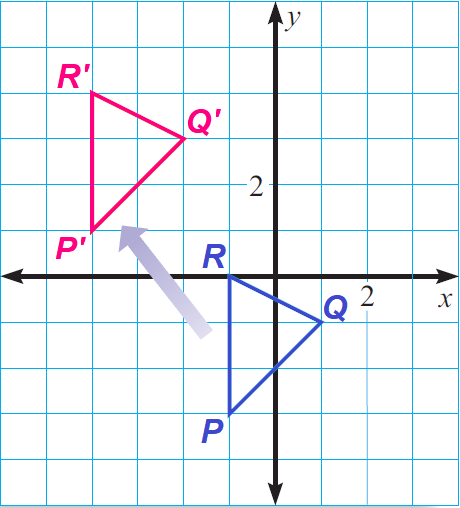
Example 4 :
In the diagram shown below, QRST maps onto Q'R'S'T' by a translation. Write the component form of the vector that can be used to describe the translation.
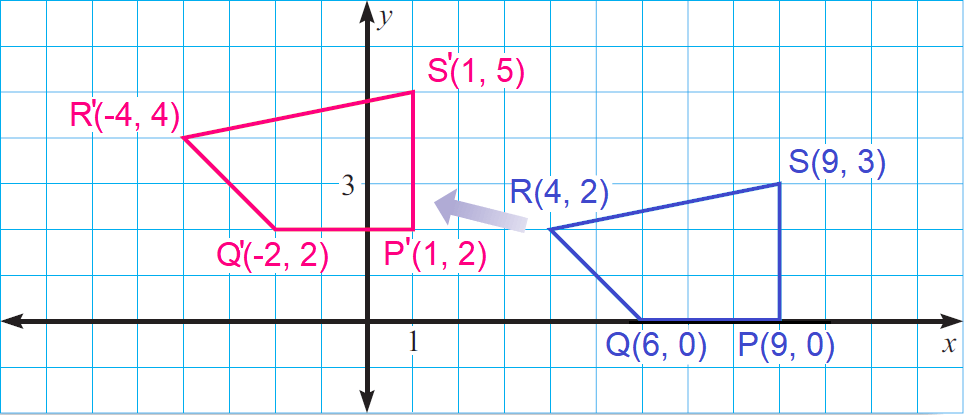
Solution :
Choose any vertex and its image, say R and R'. To move from R to R', we have to move 8 units to the left and 2 units up.
So, the component form of the vector is
〈-8, 2〉
Example 5 :
Graph the image of the figure using the transformation given.
translation: 5 units right and 1 unit up
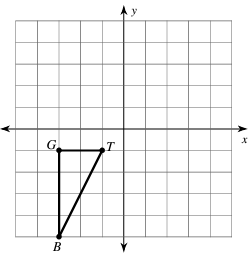
Solution :
Finding the coordinates G (-3, -1), T (-1, -1) and B (-3, -5). Original points will be in the form of (x, y). After translation point will be in the form (x + h, y + k)
Here
- h = horizontally right of 5 units, then +5
- k = vertically 1 unit up, then +1
The new point will be (x + 5, y + 1)
- G (-3, -1) ==> G'(-3 + 5, -1 + 1) ==> G'(2, 0)
- T (-1, -1) ==> T'(-1 + 5, -1 + 1) ==> T'(4, 0)
- B (-3, -5) ==> T'(-3 + 5, -5 + 1) ==> T'(2, -4)
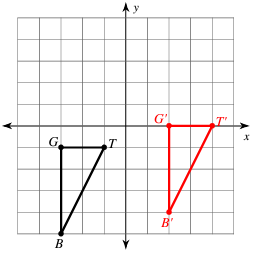
Example 6 :
translation: 1 unit left and 2 units up
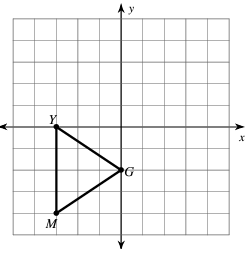
Solution :
Finding the coordinates G (-3, 0), T (0, -2) and M (-3, -4). Original points will be in the form of (x, y). After translation point will be in the form (x + h, y + k)
Here
- h = horizontally left of 1 unit, then -1
- k = vertically 2 units up, then +2
The new point will be (x - 1, y + 2)
- G (-3, 0) ==> G'(-3 - 1, 0 + 2) ==> G'(-4, 2)
- G (0, -2) ==> G'(0 - 1, -2 + 2) ==> G'(-1, 0)
- T (-3, -4) ==> T'(-3 - 1, -4 + 2) ==> T'(-4, -2)
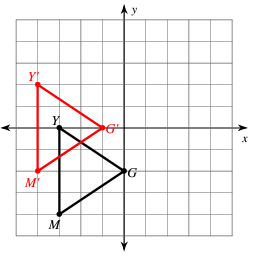
Example 7 :
Write a rule to describe each transformation.
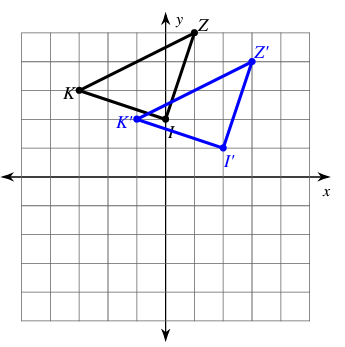
Points in the preimage are :
Z (1, 5), K (-3, 3) and I (0, 2)
Points in the image are :
Z' (3, 4), K' (-1, 2) and I' (2, 1)
Comparing the x-coordinate and y-coordinate of in Z and Z', we get
1 + 2 ==> 3
5 - 1 ==> 4
Comparing the x-coordinate and y-coordinate of in K and K', we get
-3 + 2 ==> -1
3 - 1 ==> 2
Comparing the x-coordinate and y-coordinate of in I and I', we get
0 + 2 ==> 2
2 - 1 ==> 1
Moving the graph 2 units right and 1 unit down.
Subscribe to our ▶️ YouTube channel 🔴 for the latest videos, updates, and tips.
Kindly mail your feedback to v4formath@gmail.com
We always appreciate your feedback.
About Us | Contact Us | Privacy Policy
©All rights reserved. onlinemath4all.com

Recent Articles
-
Times Table Shortcuts
Dec 30, 25 07:14 PM
Times Table Shortcuts - Concept - Examples -
10 Hard SAT Math Questions (Part - 42)
Dec 30, 25 05:52 AM
10 Hard SAT Math Questions (Part - 42) -
10 Hard SAT Math Questions (Part - 38)
Dec 29, 25 04:21 AM
10 Hard SAT Math Questions (Part - 38)

